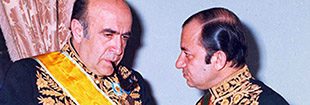Before exploring the details of Hejazi’s career, it is essential to understand the environment in which he thrived. The late 1960s and 1970s were years when Tehran evolved into a cosmopolitan metropolis. On Pahlavi Street (today Vali Asr), one could find an eclectic mixture of theaters, cafés, restaurants, and nightclubs that catered to both the Iranian elite and the growing middle class.
The nightlife culture, fueled by oil revenues and state modernization policies, saw the rise of cabarets—lavish venues with live music, dance performances, and an atmosphere that combined glamour with extravagance. Cabarets such as Shokofeh No, Miami, Champs-Elysées, Kocheh Paris, and later Baccarat were among the most talked-about venues. These places were often gateways for singers, musicians, and dancers who would later achieve fame in Iran and abroad.
Parallel to cabarets, Iranian cinema was also flourishing. The Filmfarsi era, characterized by melodramas, musicals, and thrillers, catered to mass audiences. Producers like Parviz Hejazi sought to connect the worlds of music, cabaret, and cinema, creating a cultural ecosystem that defined much of pre-revolutionary popular entertainment.

